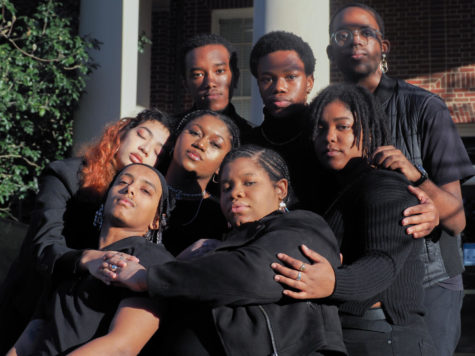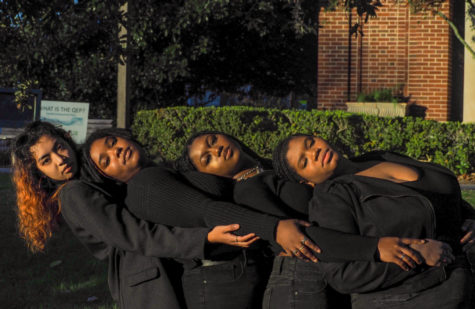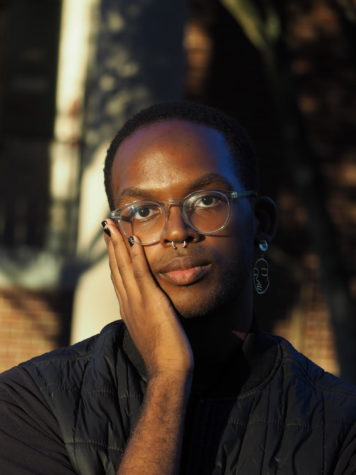Navigating intersectional safe spaces at predominantly white institutions

Figuring out how to write an article for Black History Month can be difficult. Every Black, queer student at this university has a different experience, and lumping them together can appear disingenuous.
Given this predicament, we figured that we’d highlight the experiences of as many students as possible. We also wanted to spotlight the groups and people who encourage us and help us find these spaces to exist and to belong.
Fighting for places to exist and feel safe isn’t a new concept for marginalized students at Tulane. For me, Maiya, it has been an uphill battle learning who I am as a person and realizing that who I was wasn’t wrong because a white priest from middle school told me it was.
Being Black wasn’t something that could be boiled down to my predominantly white class reading “I Have a Dream” every February, and being queer wasn’t going to send me to hell.
When I got to Tulane, finding a space like the Office of Multicultural Affairs and meeting people like Carolyn Barber-Pierre, Petey Peterson and Renee Bradley was heartwarming. I’d never had people whose job was to make sure someone like me felt included and accepted in the space I occupied.

The culture at Tulane can be a tricky space to navigate. There is currently a large lack of scholarship on the experiences of Black queer college students, specifically at predominantly white institutions. Understanding intersectionality, however, is paramount to even begin understanding the experiences of these students and how the cultures at these schools can affect them.
Kimberlé Crenshaw, the UCLA law professor who coined the term intersectionality, says she now describes it as “a lens, a prism, for seeing the way in which various forms of inequality often operate together and exacerbate each other.”
This doesn’t technically mean highlighting queer Black students as a double, triple or sometimes quadruple minority. It just means understanding that there are many parts and pieces that make up a person, and all of those parts can be celebrated together.
Tulane happens to be in one of the more diverse cities in America, as New Orleans has a diversity score of 86 out of 100. New Orleans is rich with Black and queer history alike, both cultures a vital thread of the city’s history.
“There’s so much opportunity to bring resources and resource people because of the diversity here in New Orleans,” said Carolyn Barber-Pierre, the assistant vice president for student affairs and intercultural life and a prominent New Orleans figure. “Bringing BIPOC, gay and trans folks to campus has been one of the areas we really tried to improve by working with various organizations that represent those populations and individuals.”
But, despite being in as diverse a city as New Orleans, Tulane’s Black, queer students still feel isolated and sometimes tokenized for the sake of Tulane’s promotion.
DaSean Spencer, a Black, queer student leader on campus, recognizes this often. “I get the vibe that sometimes the space[s] I enter, whether that’s professional [or] social, often like [to] recognize my [Black and queer] identities in that way and tokenize my identities in that way … ” Spencer said. “That kind of like breeds a sense of, do I even belong here?”
“I feel like sometimes there isn’t enough space for intersectionality of an individuals or groups, identities in such a predominantly white and heteronormative space,” senior Marley Igual said.

Justin Hartley, another student leader on campus, expressed that the lack of a space almost made them transfer out of Tulane. “Rarely, as a student here, have I ever felt like Tulane was home for me,” Hartley said. “I battled an unbearable imposter syndrome my first few semesters here due to the repeated idea that I only got into Tulane because I wrote a diversity statement where I divulged my deepest identities to an anonymous admission counselor.”
Not finding these spaces are why organizations like the Black Queer Collective were created, to create a place to exist for the Black, queer students on Tulane’s campus. BQC co-founder Alexa Authorlee said that a friend of hers came to her with an idea, saying that he didn’t know any other Black, queer students on campus.
Authorlee highlighted that while other organizations such as Queer Student Alliance and Queer/Trans People of Color exist as a space for queer students and queer students of color specifically, it was important that they created a space for “black queer folk to understand the intersection of anti-Blackness and having a queer identity.”
Domo Johnson and Raymell Green, both members of the executive board of the BQC, highlighted how the BQC is a space for Black queer students to have a community, a space to make friends with people who share similar identities and to have fun.
“[The BQC,] that’s really helped me kind of come more in tune with being Black and gay and what that intersectionality means to me and how it impacts me personally,” Green said.
The Office of Gender and Sexuality has also created a new position for their office, an assistant director for queer/trans BIPOC engagement and assessment, which is held by Renee Bradley. This position was created because Bradley observed that queer and trans students of color weren’t gravitating towards the office, and when they were they weren’t being supported.
“I was trying to figure out ways that I could make the office more accessible and create programming that really kind of catered and tailored to their needs,” Bradley said.
“I think we’re doing more to create that community, but I also feel like we have a long way to go, right?” OGSD Director Petey Peterson said.
The community of Black, queer students is blossoming on Tulane’s campus and is taking the space that it deserves.
For students to feel as if they belong here as much as the majority, Tulane needs to work harder in acknowledging that space and this amazing group of students, beyond tokenizing them for their own gain.
Your donation will support the student journalists of Tulane University. Your contribution will allow us to purchase equipment and cover our annual website hosting costs.


